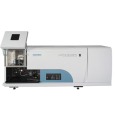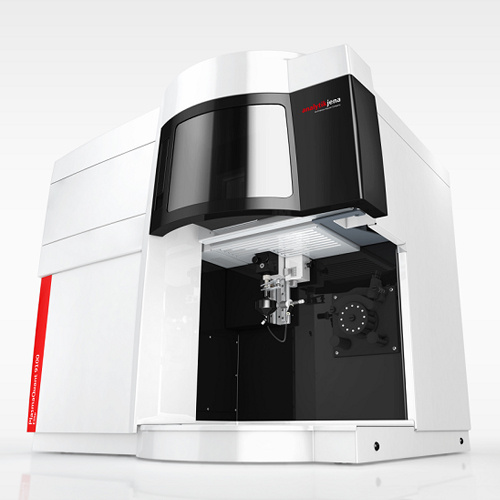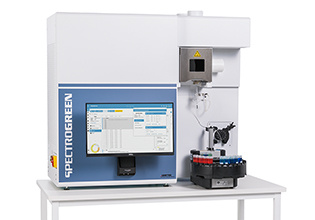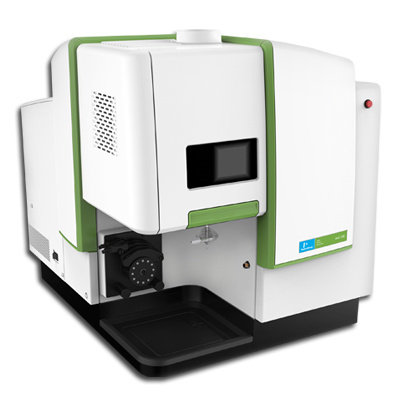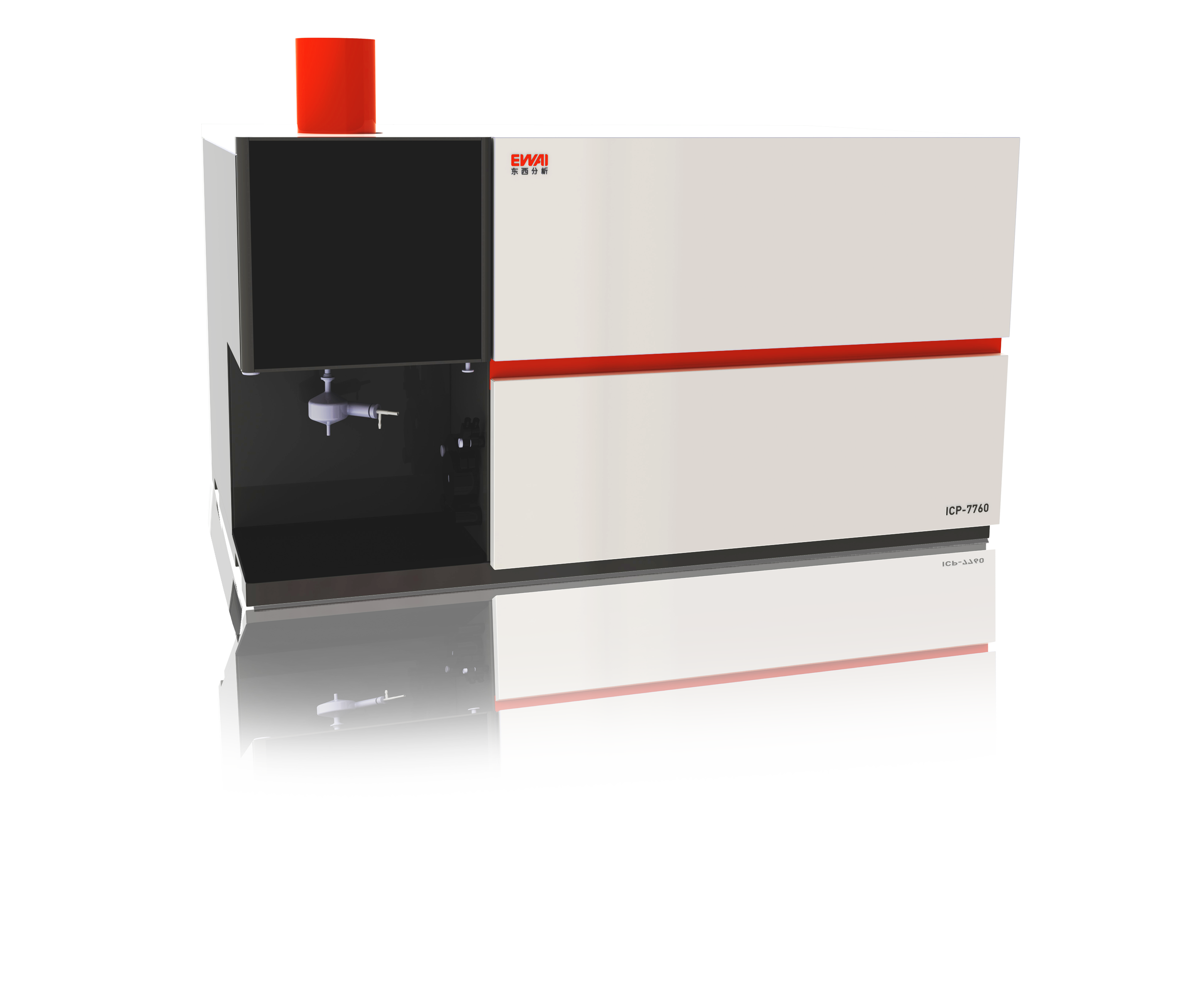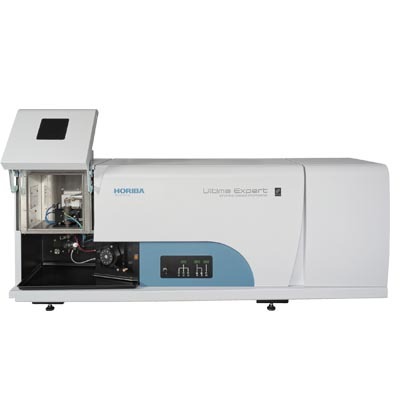
方案详情
文
The use of BIPEA samples allows the validation of the technique and the analytical method that was developed. The calculated recoveries are all acceptable. The ULTIMA 2 used with the AS 421 autosampler allows the user to run food, provender and nutritive samples with the same method. This contributes to the ease of use and reliability of the method and results.
方案详情

ICP ATOMIC EMISSION SPECTROSCOPYAPPLICATION NOTE 38 Application of ICP-OES to the Analysis of Food andAgriculture: turkey, pork, hay and soy samples M. SORIN, Cana, Laboratoire Central, Ancenis, France Agnes COSNIER, HORUIBA Scientific Longjumeau, France Keywords: food, agriculture The determination of major elements in food,cereals or nutritive solutions is essential fornutritional significance. This necessitates a reli-able techniquefor good accuracy and preci-sion. The ULTIMA 2 ICP-AES spectrometer wasused. This paper presents a description of thetechnique,operating conditions and someresults of certified materials. 2 Principle 2.1 Technique used The elemental analysis of these samples wasundertaken by Inductively Coupled PlasmaAtomic Emission Spectrometry (ICP-AES). Thesample is nebulized then transferred to anargon plasma. It is decomposed, atomized andionized whereby the atoms and ions are excited.We measure the intensity of the light emittedwhen the atoms or ions return to lower levels ofenergy. Each element emits light at characteris-tic wavelengths and these lines can be used forquantitative analysis after a calibration. 2.2 Wavelength choice The choice of the wavelength in a given matrixcan be made using the profile function, or byusing Win-IMAGE, which is rapid semi-quantita-tive analysis mode using multiple wavelengths.The principle is the same in either case: recordthe scans of analytes at low concentration andof the matrix. By superimposing the spectra, wesee possible interferences. 3 Sample Preparation The preparation was done following the NormXPV 18-116, Dec 1995. 5 g of sample are calci-nated at 550 C during 6 hours. The ashes arelthen diluted with 37 % HCI and demineralizedwater (solution completed to 250 ml). The finaconcentration of acid is 2.5 %. 4 Calibration and analysis mode 6 multi-element standards were prepared in2.5% HCI. The solutions used for calibration arelisted in the Table 1 (in mg/L). 5 Instrument specification The work was performed on a ULTIMA 2 withthe specifications shown below. Table 2:Specification of spectrometer Parameters Specifications Mounting Czerny-Turner Focal length 1 m Optics thermoregulation Yes Variable resolution Yes Nitrogen purge Yes Grating (number of grooves) 2400 gr/mm Orders 2 1st order resolution 0.005 nm 2nd order resolution 0.010 nm Element STD0 STD1 STD2 STD3 STD4 STD5 Unit Ca 0 0.002 0.005 0.02 0.04 0.05 % Cu 0 0.10 0.25 1.00 2.00 2.50 mg/kg Fe 0 0.40 1.00 4.00 8.00 10.00 mg/kg K 0 0.002 0.005 0.02 0.04 0.05 % Mg 0 0.0004 0.001 0.004 0.008 0.01 % Mn 0 0.20 0.50 2.00 4.00 5.00 mg/kg Na 0 0.001 0.0025 0.01 0.02 0.025 % P 0 0.001 0.0025 0.01 0.02 0.025 % Zn 0 0.20 0.50 2.00 4.00 5.00 mg/kg Table 3: Specification of RF Generator Parameters Specifications Type of generator Solid state Observation Radial view Frequency 40.68 MHz Control of gas flowrate By computer Control of sample uptake By computer Cooling Air The operating conditions of the spectrometer arelisted in Table 4. Table 4: Operating conditions Parameter Condition Generator power 1000 W Plasma gas flowrate 13 L/min Auxiliary gas flowrate 0 L/min Sheath gas flowrate 0.2 L/min Nebulizer 0.8 L/min at 3 bars Sample uptake 1 mL/min Type of nebulizer Glass concentric Type of spray chamber cyclonic Glass Argon humidifier No Injector tube diameter 3.0 mm 6 Wavelength selection and analytical conditions The acquisition parameters are listed in Table 5. Table 5: acquisitions parameters Element Wavelength Measuring Calculating Integration Entrance Exit Calculation (nm) point point time slit slit mode (s) (um) (um) Ca 317.933 1 1 4 20 80 Max Cu 324.754 1 1 4 20 80 Max Fe 259.940 1 1 4 20 80 Max K 766.490 1 1 4 20 80 Max Mg 279.079 1 1 4 20 80 Max Mn 257.610 1 1 4 20 80 Max Na 589.592 1 1 4 20 80 Max P 214.914 7 5 2 20 15 Gauss Zn 213.856 1 1 4 20 80 Max The results are given for various samples in Table6 to 9. Each sample has been digested twice tohave 2 analysis replicates. The obtained concentra-tion is the mean of the 2 calculated concentrationsusing 3 replicates each. They are compared withresults given by the Bureau Interprofessionel d'EtudesAnaytiques (BIPEA). This group organizes inter-lab-oratory tests in agriculture, food and environmen-tal fields. It allows the laboratories to assess the qual-ity ofthe analyses. They give concentration resultsofinter-comparison tests and associated errors at 3sigma. Element )Obtained SD BIPEA Recovery (% concentration concentration (o.c./ b.c. x 100) (O.C.) (b.c.) Ca 0.254% 0.005 0.27±0.05 94.1 Cu 15.358 mg/kg 0.0.6 16±4 96.1 Mn 36.516 mg/kg 0.17 38±6 96.1 P 0.594% 0.0085 0.63±0.05 94.3 Zn 46.687 mg/kg 0.23 50±7 93.4 Table 7: Turkey sample Element Obtained SD BIPEA Recovery (%) concentration concentration (o.c./b.c. x 100) (o.c.) (b.c.) Ca 1.082% 0.023 1.10±0.13 98.4 Cu 27.586 mg/kg 0.28 28±5 98.5 Fe 256.25 mg/kg 2.67 268±59 95.6 K 1.128% 0.0015 1.22±0.14 92.5 Mg 0.208% 0.002 0.22±0.04 95.0 Mn 97.02 mg/kg 1.76 103±12 94.2 Na 0.140% 0.0035 0.16±0.04 87.5 P 0.757% 0.012 0.78±0.06 97.1 Zn 83.572 mg/kg 1.63 88±11 95.0 Table 8: Hay sample These results are concentration on dry mass (d.m.) Element Obtained SD BIPEA Recovery (%) concentration concentration (o.c./ b.c.x 100) (o.c.) (b.c.) Ca 2.90 g/kg d.m. 0.078 3.1±0.5 93.5 Cu 4.7 mg/kg d.m. 0.027 5.1±4.3 92.2 Mg 1.21 g/kg d.m. 0.014 1.3±0.2 93.1 P 2.03 g/kg d.m. 0.078 2.2±0.4 92.3 Zn 25.2 mg/kg d.m. 0.85 26.6±3.8 94.7 Scientific Table 9: Pork sample Element Obtained SD BIPEA Recovery (%) concentration concentration (o.c./ b.c.x 100) (o.c.) (b.c.) Ca 0.625% 0.021 0.65±0.09 96.2 Cu 78.95 mg/kg 0.099 82±10 96.3 Fe 215.79 mg/kg 4.3 221±49 97.6 K 0.67% 0.004 0.70±0.09 95.7 Mg 0.14% 0.0015 0.14±0.03 100 Mn 35.91 mg/kg 0.69 39±6 92.1 Na 0.12% 0.0009 0.14±0.03 85.7 P 0.42% 0.014 0.44±0.04 95.5 Zn 78.76 mg/kg 4.95 80±10 98.5 8 Conclusion The use of BIPEA samples allows the validation ofthe technique and the analytical method that wasdeveloped. The calculated recoveriesare allacceptable. The ULTIMA 2 used with the AS 421autosampler allows the user to run food, proven-der and nutritive samples with the same method.This contributes to the ease of use and reliabilityof the method and results. Scientific HORIBA ORIBAScientific The use of BIPEA samples allows the validation of the technique and the analytical method that was developed. The calculated recoveries are all acceptable. The ULTIMA 2 used with the AS 421 autosampler allows the user to run food, provender and nutritive samples with the same method. This contributes to the ease of use and reliability of the method and results.
确定

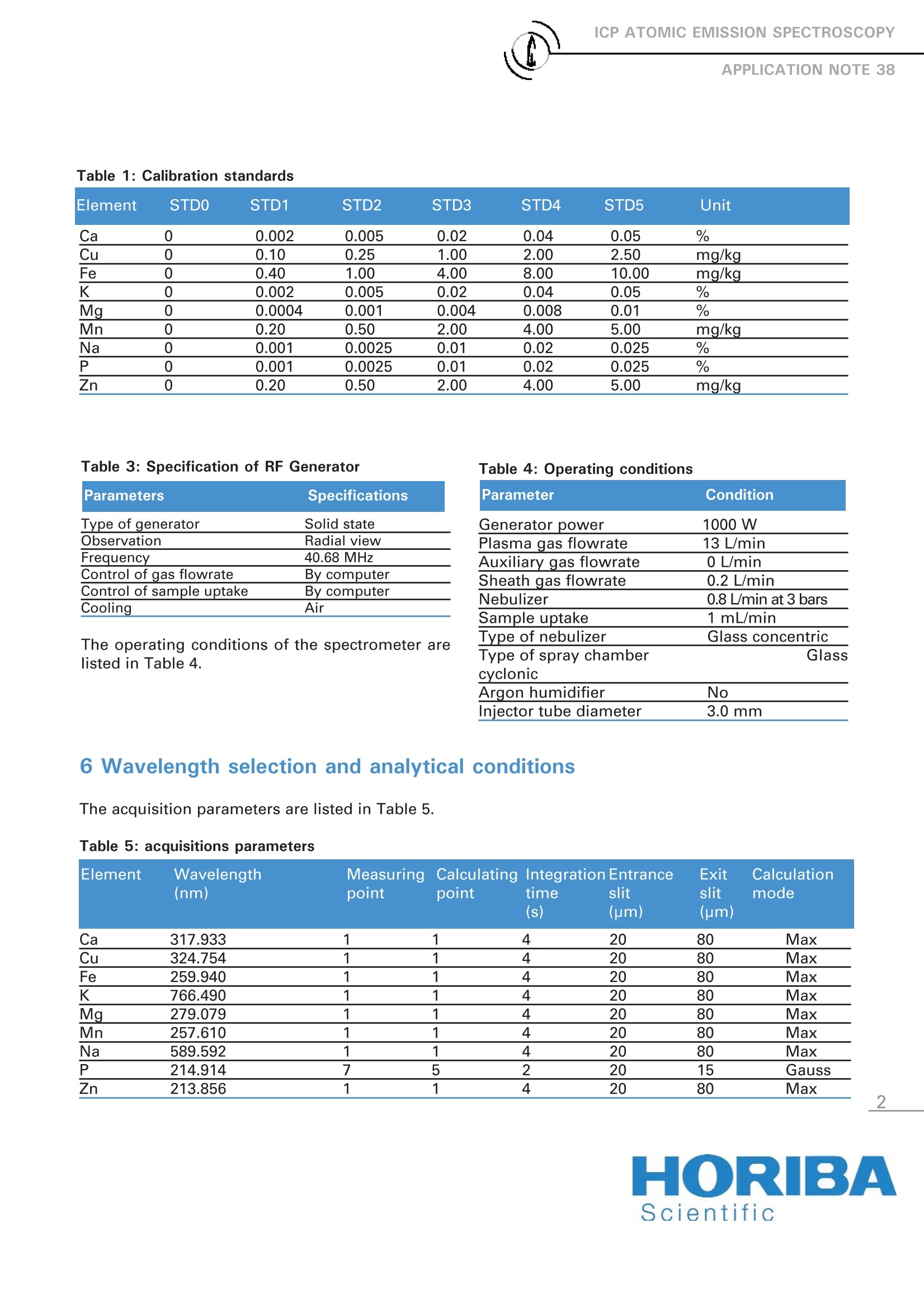
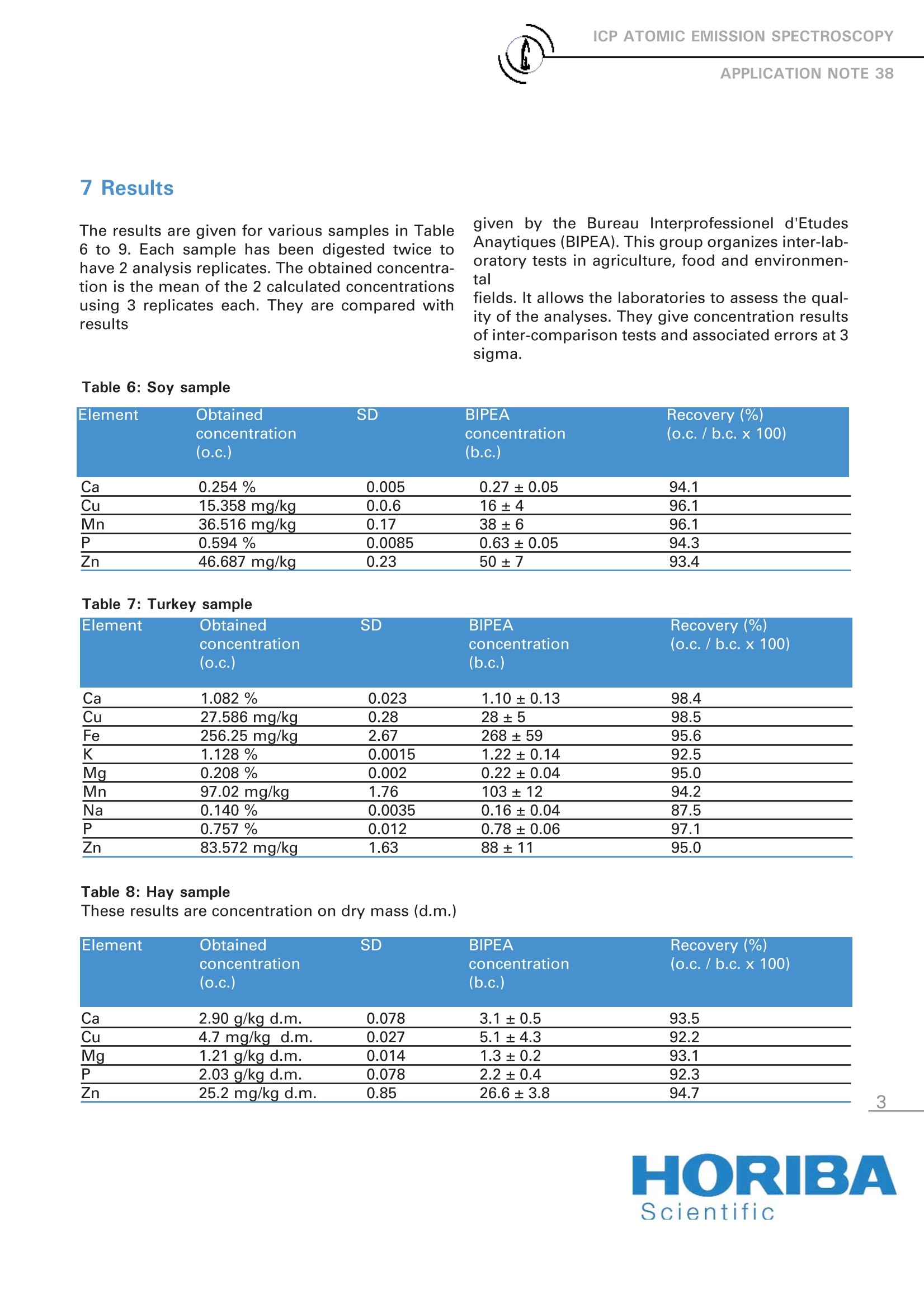
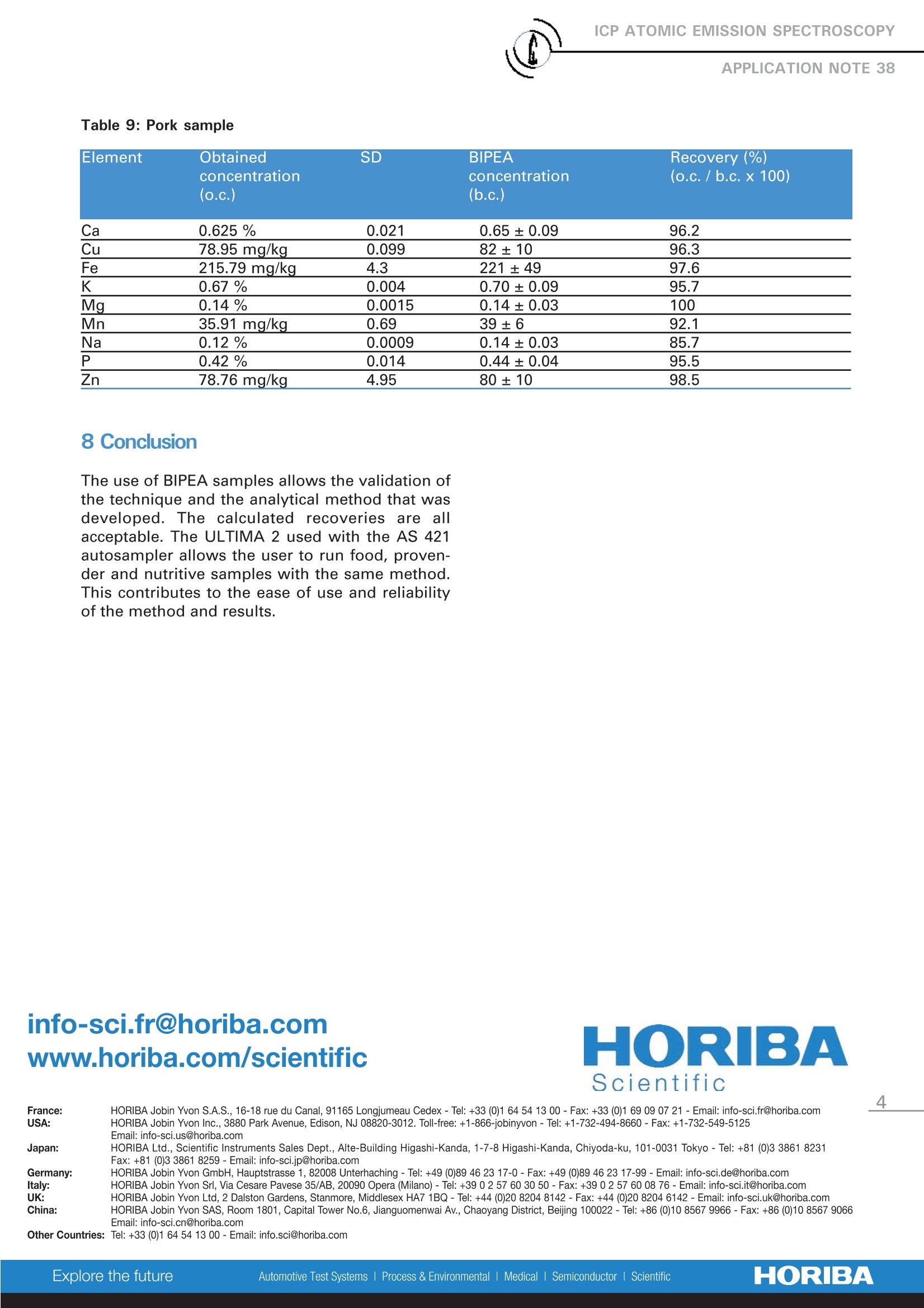
还剩2页未读,是否继续阅读?
HORIBA(中国)为您提供《食物中元素检测方案(ICP-AES)》,该方案主要用于其他食品中元素检测,参考标准--,《食物中元素检测方案(ICP-AES)》用到的仪器有HORIBA Ultima Expert高性能ICP光谱仪
推荐专场
相关方案
更多
该厂商其他方案
更多









